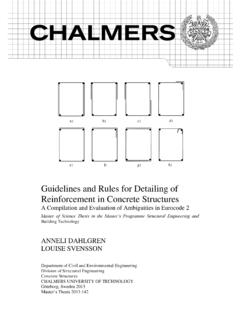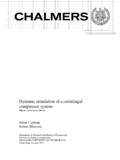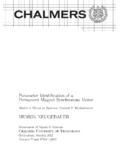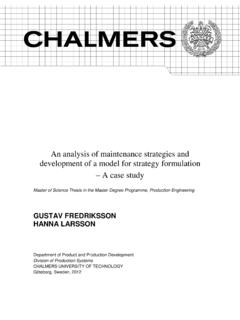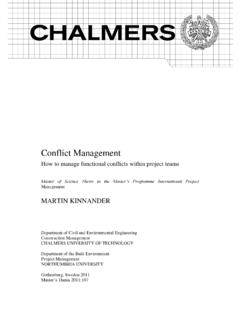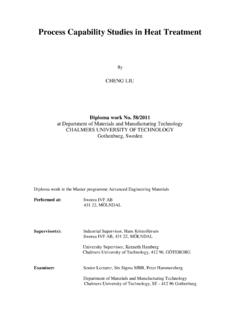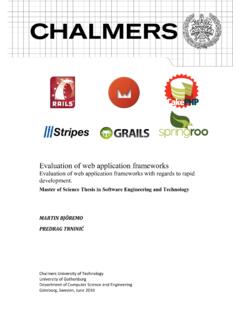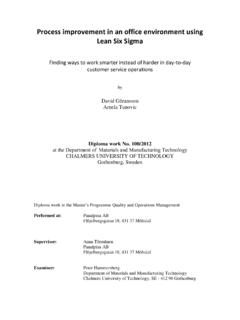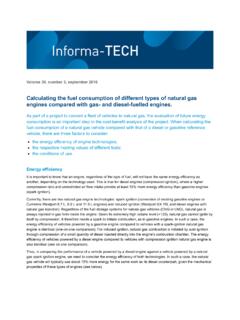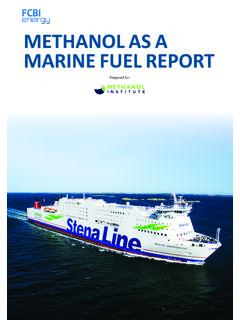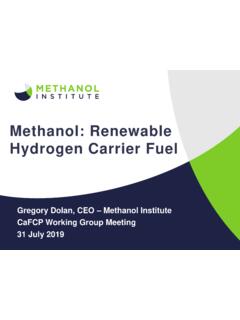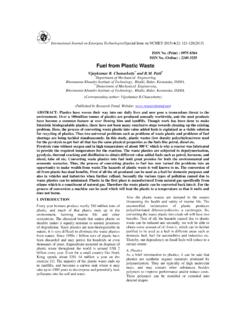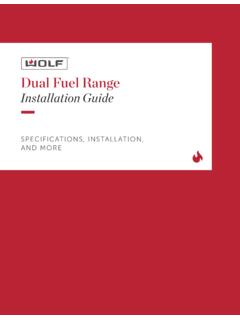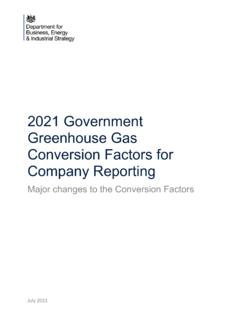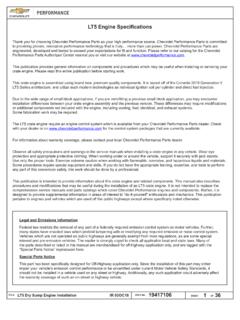Transcription of Ammonia as fuel for internal combustion engines
1 Ammonia as fuel for internal combustion engines ? An evaluation of the feasibility of using nitrogen-based fuels in ICE. Master s Thesis in Sustainable Energy Systems EMTIAZ ALI BROHI Department of Applied Mechanics Division of combustion Name of research group CHALMERS UNIVERSITY OF TECHNOLOGY Gothenburg, Sweden 2014 Master s thesis 2014:55 MASTER S THESIS IN SUSTAINABLE ENERGY SYSTEMS Ammonia as fuel for internal combustion engines ? An evaluation of the feasibility of using nitrogen-based fuels in ICE. EMTIAZ ALI BROHI Department of Applied Mechanics Division of combustion CHALMERS UNIVERSITY OF TECHNOLOGY Gothenburg, Sweden 2014 Ammonia as fuel for internal combustion engines ?
2 An evaluation of the feasibility of using nitrogen-based fuels in ICE. EMTIAZ ALI BROHI EMTIAZ ALI BROHI, 2014 Master s Thesis 2014:55 ISSN 1652-8557 Department of Applied Mechanics Division of combustion Chalmers University of Technology SE-412 96 Gothenburg Sweden Telephone: + 46 (0)31-772 1000 Cover: Buses in Belgium during World War II, fuelled by Ammonia [Kroch E.]. Chalmers Reproservice Gothenburg, Sweden 2014 I Ammonia as fuel for internal combustion engines ? An evaluation of the feasibility of using nitrogen-based fuels in ICE. Master s Thesis in Sustainable Energy Systems EMTIAZ ALI BROHI Department of Applied Mechanics Division of combustion Chalmers University of Technology ABSTRACT Although alternative fuels are being widely discussed for internal combustion engines (ICE), little attention and knowledge is available on nitrogen based fuel .
3 An interesting idea is if it s possible get into the worlds natural nitrogen cycle, instead of the carbon cycle. That means capturing nitrogen in a similar, but easier fashion as capturing CO2 from air. Therefore, the aim of the study is to investigate nitrogen based fuels to be used in existing ICE with as small modifications of the engine design as possible. The criteria of nitrogen based, closed loop produced fuel compatible with the design of an existing ICE utilizing small design modifications would be a breakthrough in the global vehicle fleet. A theoretical study was conducted in order to investigate the possibility of using nitrogen-based fuels in internal combustion engines .
4 This idea prompted up since Ammonia has been used as fuel for buses in Belgium during World War II [Kroch E]. Modern time issues such as climate change and depletion of fossil fuels could be solved by using a possible carbon-free nitrogen-based fuel . There are several nitrogen based fuel / fuel mixtures but not all are suitable for use in existing engine designs since many of these are aimed for use as rocket fuel . Our judgement is that Ammonia , mainly used in dual fuel concepts, is the only convenient nitrogen based fuel for possible use in internal combustion engines in an reasonable future unless a major scientific breakthrough occurs. Ammonia is today mainly produced from natural gas that emits a large amount of carbon dioxide when combusted.
5 It is thus more convenient to use natural gas direct in a natural gas vehicle rather than producing Ammonia of it. Alternative production processes based on sustainable sources, solar and wind (electricity) can t compete economically with hydrocarbons. A possible competitive carbon-neutral production method for future is to produce Ammonia by biomass gasification that would enable almost zero carbon emission propulsion when considering Well-To-Tank. Using biomass for Ammonia is better than using it for bio- fuel (hydrocarbon) production considering corn as feedstock. This is due to the larger amount of corn needed for bio- fuel production compared to Ammonia production.
6 A future use of biomass for Ammonia production opens a window of opportunity to realize a carbon-free Well-To-Wheel chain. There are no engines currently that can run on Ammonia , or Ammonia as dual - fuel , at today s standards and with the same operating conditions. The work performed are rather at research level, mainly as fuel research on Cooperative fuel Research (CFR) II engines , and have some way to go before being possible for engine application in transport vehicles. There is no engine architecture at present that supports Ammonia as fuel . Ammonia as fuel for internal combustion engines is not possible in the near-term future if a carbon-free Well-To-Wheel chain is required.
7 It might be possible, if further research is conducted in future. Nitrogen based fuels do not seem to be an alternative for low Green House Gas (GHG) emissions in automotive engines . Currently, only Ammonia seems feasible as fuel in engines . Being locally low-carbon , meaning emitting no or low GHG emissions, it cannot compete on the total Well-to-Wheel chain. Additionally there is a large gap in the engine technology and application to meet todays and future requirements. Key words: Ammonia , nitrogen based fuel , internal combustion engine , well-to-wheel, well-to-tank, Ammonia production, carbon-free, fuel , hydrogen, Haber-Bosch, electrolysis III Contents 1 INTRODUCTION 1 2 BACKGROUND 2 3 NITROGEN BASED FUELS 3 Ammonia 4 Ammonia in dual - fuel applications 5 Hydrazine 5 Liquid nitrogen 5 Basic research fuels and specialized application fuels 6 Highly specialized application fuels and basic research level fuels 6 Basic research level fuels 6 Summary of nitrogen based fuel 7 4 WELL-TO-TANK CONSIDERATIONS ( Ammonia )
8 8 Production of Ammonia 8 Current, main stream, production method 8 Alternative Ammonia production methods 9 Discussion on Ammonia feasibility 10 Comparison of natural gas for Ammonia production or direct use in a vehicle 11 Electricity for Ammonia production compared to gasoline production 12 Biomass for Ammonia production compared to bio- fuel production 13 Summary 14 5 AUTOMOTIVE PROPULSION ON NITROGEN-BASED FUELS 15 Possible Ammonia based propulsion 15 Ammonia in ICE 16 Compression-ignition engine 16 Spark-ignition engine 17 fuel cells 18 Ammonia fuel cell 18 Hydrazine fuel cell 19 Summary 19 6 DISCUSSION AND CONCLUSION 20 7 REFERENCES 22 II APPENDIX I (Search methods to)
9 Find possible nitrogen based fuels) APPENDIX II ( Ammonia s compatibility with infrastructure) Preface In this study, the possibility of using nitrogen based fuels compatible with existing engine concepts/designs, with no major change of the industrial structure, was investigated. The work has been carried out from January 2014 to June 2014. This project is an initial study by Volvo Car Corporation to investigate if it is possible to find a fuel in the natural nitrogen cycle, based on nitrogen instead of carbon, in order to reduce CO2 emissions (GHG) in transport vehicles. The study was carried out at Volvo Car Corporation in Sweden, with literature search conducted at Chalmers university s library.
10 This study was financed by Volvo Car Corporation. The project has been carried out with the help of Mr Lars-Olof Carlsson as supervisor and with Dr Andreas Hinz as the champion of this topic. Examiner at Chalmers University of Technology is Professor Ingemar Denbratt. Their role in this study has been appreciated very much; this study could never have been conducted without their help and professionalism. Gothenburg, Sweden June 2014 Emtiaz Ali Brohi IV Notations ASU Air Separation Unit CCS Carbon Capture and Storage CI engine Compression-Ignition engine CNG Compressed Natural gas EHB Electrolysis with Haber-Bosch process GHG Greenhouse gases ICE internal combustion engine MMH Monomethylhydrazine OTEC Ocean Thermal Energy Conversion SI engine Spark-Ignition engine SMR Steam Methane Reforming SSAS Solid State Ammonia Synthesis TTW Tank-to-Wheel UDMH Unsymmetrical Dimethylhydrazine WTT Well-to-Tank WTW Well-to-Wheel CHALMERS, Applied Mechanics, Master s Thesis 2014.

